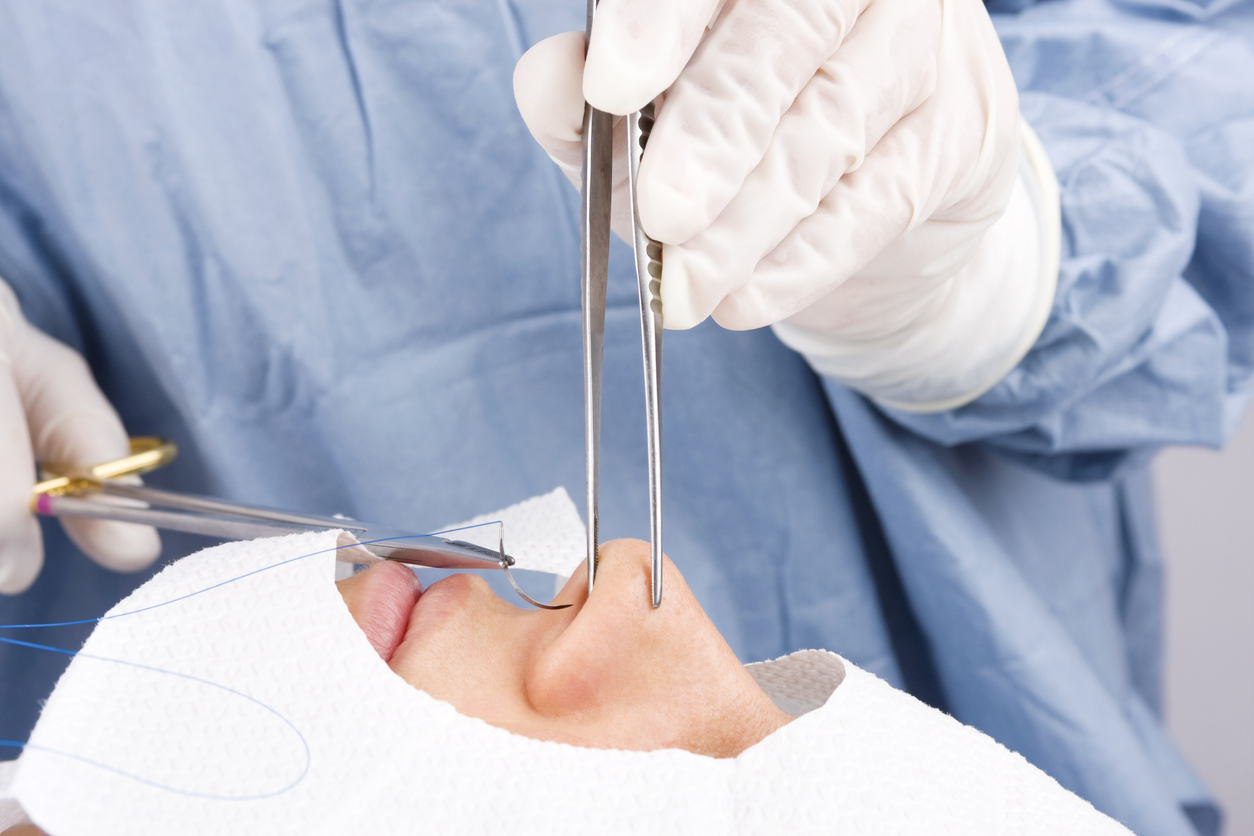When it comes to non-surgical nose enhancements, two popular options stand out: the suture lift and the thread lift. Both promise a more refined nasal shape without the downtime of traditional rhinoplasty, but they work in different ways and offer unique benefits.
So, how do you decide which one is best for you?
In this blog, we’ll break down the key differences, advantages, and considerations for each procedure, helping you make an informed choice for your perfect nose transformation.
Key Takeaways
- Suture lifts and thread lifts both reshape the nose but use different techniques.
- Thread lifts are less invasive and often referred to as a ‘lunchtime nose job.’
- Suture lifts may offer more precision for certain nose shapes and goals.
- Costs vary significantly, with thread lifts generally being more affordable.
- Consulting a specialist is crucial to determine the best choice for you.
Understanding the Basics of Suture Lifts and Thread Lifts
What Is a Suture Lift?
A suture lift is a minimally invasive cosmetic procedure designed to reshape and lift specific areas of the face or body using specialised sutures. These sutures are strategically placed beneath the skin to provide support and reposition tissues.
Unlike traditional surgical lifts, suture lifts aim for a subtle enhancement with reduced recovery time. The results are often immediate, giving patients a refreshed appearance without the need for major surgery.
What Is a Thread Lift?
Thread lifts, on the other hand, involve the use of biodegradable threads to elevate and contour areas like the nose, cheeks, or jawline. These threads not only lift but also stimulate collagen production, which can improve skin texture over time. The procedure is quick—sometimes called a “lunchtime lift”—and typically requires only local anaesthetic. While the results are temporary, they offer a non-surgical alternative for those seeking a modest improvement.
Key Differences Between the Two
Here’s a quick comparison:
| Feature | Suture Lift | Thread Lift |
|---|---|---|
| Invasiveness | Minimally invasive | Non-invasive |
| Material Used | Specialised sutures | Biodegradable threads |
| Collagen Stimulation | No | Yes |
| Duration of Results | Longer-lasting (up to years) | Temporary (up to a year) |
| Procedure Time | 1-2 hours | Less than an hour |
Both procedures are tailored to individual needs, making it important to consult with a qualified practitioner to determine the best option for you.
Procedure Insights: How Suture Lifts and Thread Lifts Work
The Process Behind Suture Lifts
Suture lifts are a more traditional option for reshaping the nose. This procedure involves the careful placement of specialised sutures beneath the skin to lift and contour the nasal structure. Unlike thread lifts, suture lifts may require small incisions, which are strategically hidden to minimise visible scarring.
The surgeon adjusts the sutures to achieve the desired shape and symmetry, providing a more defined and permanent result. This technique is commonly chosen for individuals seeking a dramatic improvement.
The Mechanics of Thread Lifts
Thread lifts, often referred to as the “lunchtime nose job,” are a minimally invasive alternative. Instead of making incisions, the practitioner inserts polydioxanone (PDO) threads into specific areas of the nose.
These threads are biodegradable and stimulate collagen production as they dissolve over time. The procedure typically takes less than an hour and is performed under local anaesthesia. Thread lifts are ideal for subtle enhancements, such as lifting the nasal tip or refining the bridge.
Safety and Precision in Both Procedures

Both suture lifts and thread lifts are designed with safety in mind, but the level of invasiveness differs. Thread lifts are less invasive, leading to a quicker recovery and fewer risks of complications like infection or scarring. Suture lifts, while slightly more involved, offer a higher level of precision for complex reshaping. Choosing the right option often depends on your goals, anatomy, and the expertise of your surgeon.
If you’re unsure which procedure suits your needs, consulting with a qualified specialist can help clarify your options and set realistic expectations.
Comparing Results: What to Expect from Each Treatment
Immediate and Long-Term Outcomes
Both suture lifts and thread lifts offer noticeable improvements shortly after the procedure. With a suture lift, you might see a subtle refinement in the nose’s structure within a few days. Thread lifts, on the other hand, often deliver quicker results as the threads physically lift the skin right away.
Over time, both treatments encourage collagen production, which can further enhance the appearance. The long-term benefits depend heavily on your skin type and how well you follow aftercare instructions.
Natural vs. Dramatic Changes
If you’re aiming for a more pronounced alteration to the shape of your nose, a suture lift might be the better option. It allows for precise adjustments and can achieve a slightly more dramatic effect. Thread lifts, however, are ideal for those who prefer a natural, understated enhancement. The threads work subtly to improve contours without making the change too obvious.
Think of it as the difference between a bold statement and a gentle whisper—both effective, but in different ways.
Longevity of Results
| Procedure | Typical Duration of Results | Factors Affecting Longevity |
|---|---|---|
| Suture Lift | 1–2 years | Skin elasticity, lifestyle choices |
| Thread Lift | 6 months–1 year | Thread material, collagen response |
While suture lifts tend to last longer, thread lifts are often chosen for their quick recovery and lower commitment. It’s worth noting that maintenance treatments can help extend the benefits of either procedure.
Choosing between these two options often comes down to your personal goals and how long you’re hoping the results will last. Consider what fits your lifestyle and expectations best.
Cost Considerations: Budgeting for Your Nose Job
Price Range for Suture Lifts
Suture lifts, while less invasive than traditional surgical rhinoplasty, still come with a significant price tag. On average, you can expect to pay anywhere from £1.500 to £4,000, depending on the clinic and the expertise of the surgeon.
Costs may vary based on the complexity of the procedure, as some cases require more intricate work to achieve the desired results.
Cost of Thread Lifts
Thread lifts are generally more affordable than suture lifts. The typical price range for a nose thread lift falls between £1,500 and £3,500. This is largely due to the minimally invasive nature of the procedure and the shorter time required to perform it.
However, keep in mind that thread lifts might need to be repeated every 1-2 years to maintain the effect, which could add up over time.
Factors Influencing the Overall Expense
Several elements can impact the total cost of your procedure. Here’s a quick breakdown:
- Geographical location: Clinics in major cities or upscale neighbourhoods often charge more.
- Surgeon’s experience: A highly skilled or renowned surgeon may have higher fees.
- Anaesthesia and facility fees: These can vary depending on whether the procedure is performed in a clinic or hospital setting.
- Post-procedure care: Medications, follow-up appointments, and any additional treatments can contribute to the final bill.
Budgeting for a nose job is about more than just the upfront cost. Consider the long-term value of the procedure, especially when comparing options like suture lifts and thread lifts. Investing in quality care often leads to more satisfying and lasting results.
Recovery and Aftercare: What You Need to Know
Healing Time for Suture Lifts
Recovery from a suture lift is typically manageable, but it does require a bit of patience. Most people experience mild swelling and bruising for the first week, but these side effects usually subside quickly. By the second or third week, you can expect to resume most of your regular activities. However, strenuous exercise and heavy lifting should be avoided for at least four weeks.
Here’s a quick breakdown of the recovery timeline:
| Timeframe | What to Expect |
|---|---|
| First 24–48 hours | Mild pain, swelling, and potential bruising |
| Day 3–7 | Reduced swelling and gradual improvement |
| Week 2–3 | Return to light activities; most bruising subsides |
| Week 4+ | Resume all normal activities |
Recovery Period for Thread Lifts
Thread lifts, being less invasive, often come with a shorter recovery time. You might notice some minor swelling or redness immediately after the procedure, but these effects usually fade within a few days. Many patients return to work or their daily routine within 48 hours.
Tips to keep in mind for thread lift recovery:
- Sleep with your head elevated for the first few nights to minimise swelling.
- Avoid touching or massaging the treated area to prevent thread displacement.
- Refrain from high-intensity workouts for at least a week.
Tips for Optimal Aftercare
Proper aftercare is key to achieving the best results from either procedure. Here are some universal tips:
- Stay hydrated. Drinking plenty of water supports overall healing.
- Stick to a healthy diet rich in vitamins to promote tissue repair.
- Use cold compresses to reduce swelling but avoid applying direct pressure.
- Follow all post-procedure instructions provided by your specialist.
- Schedule and attend follow-up appointments to monitor your progress.
Recovery is a gradual process, so give your body the time it needs to heal. With the right care and precautions, you can enjoy the full benefits of your chosen procedure.
Suitability: Which Procedure Matches Your Needs?
Ideal Candidates for Suture Lifts
Suture lifts are often suitable for individuals looking for a more structured and defined enhancement. If your goal is to achieve a noticeable lift with a stronger framework, this option might be ideal. Patients with thicker skin or more significant sagging may benefit more from a suture lift.
Key considerations for candidates:
- You desire a longer-lasting result.
- You can tolerate a slightly more invasive procedure.
- You have realistic expectations about recovery time and outcomes.
Who Should Consider Thread Lifts?
Thread lifts are a fantastic choice for those seeking subtle, natural-looking changes. This method works best for individuals with mild to moderate skin laxity. It’s a less invasive option, making it attractive for people who prefer minimal downtime.
Ideal for:
- Patients who meet the minimum age requirement in the UK or those experiencing only mild sagging.
- Individuals who want a quick procedure with immediate results.
- Patients prioritising a non-surgical approach.
Customising Your Treatment Choice
Selecting the right procedure often depends on your unique facial structure, skin type, and aesthetic goals. During a consultation, your specialist will evaluate these factors and guide you toward the most suitable option. Combining techniques is also possible for tailored results.
Benefits and Drawbacks: Weighing Your Options
Advantages of Suture Lifts
- Long-lasting results: Suture lifts are designed to provide a more durable outcome compared to thread lifts, often lasting several years.
- Precision-focused: This procedure allows for meticulous adjustments, making it ideal for patients seeking significant reshaping.
- Minimal maintenance required post-procedure, reducing the need for frequent follow-ups.
Pros of Thread Lifts
- Non-invasive and quick: Thread lifts are minimally invasive and usually completed within an hour.
- Affordable alternative: They are often less expensive than suture lifts, making them a budget-friendly option.
- Natural-looking results: Ideal for subtle enhancements rather than dramatic changes.
Potential Limitations of Each
| Aspect | Suture Lifts | Thread Lifts |
|---|---|---|
| Longevity | Several years | Typically 1-2 years |
| Cost | Higher | Lower |
| Recovery Time | Moderate | Minimal |
| Ideal Candidates | Those seeking major reshaping | Those preferring minor tweaks |
Choosing between a suture lift and a thread lift boils down to your personal goals, budget, and willingness to commit to a longer recovery period. Both options have their strengths and challenges, so it’s a matter of aligning the procedure with your expectations.
Expert Advice: Making the Right Decision
Consulting a Specialist
When considering a nose job, the first and most important step is to consult a qualified professional. A skilled practitioner can assess your unique facial structure, skin type, and personal goals to recommend the best option for you.
Look for someone who specialises in non-surgical nose enhancements and has a strong portfolio of successful outcomes. Don’t hesitate to ask about their credentials and experience with both suture lifts and thread lifts.
Questions to Ask During Your Consultation
To make the most of your consultation, come prepared with questions. Here are a few to consider:
- What are the risks and benefits of each procedure for my specific case?
- How long will the results last, and what kind of maintenance is required?
- What is the recovery process like for each option?
- Can I see before-and-after photos of patients with similar features to mine?
- Are there any alternative treatments I should consider?
A productive consultation is a two-way conversation. Be open about your expectations and concerns so your specialist can guide you appropriately.
Preparing for Your Chosen Procedure
Once you’ve decided on a suture lift or thread lift, preparation is key. Here are a few steps to get you ready:
- Follow any pre-procedure instructions, such as avoiding certain medications or supplements.
- Plan for a lighter schedule post-procedure to allow time for recovery.
- Arrange transportation if sedation or numbing agents will be used.
- Stock up on any recommended aftercare products, such as soothing creams or cold compresses.
Taking the time to prepare thoroughly can make your experience smoother and your results more satisfying.
By approaching the decision-making process thoughtfully, you’ll be well on your way to achieving the nose enhancement that best suits your needs and lifestyle.
Conclusion
Choosing between a suture lift and a thread lift for your nose ultimately comes down to your personal goals, budget, and how much downtime you can manage. Both options have their own set of benefits and limitations. A thread lift offers a quicker, less invasive route with subtle results, while a suture lift might be better suited for those seeking more dramatic, longer-lasting changes.
Take your time to weigh the pros and cons, and consult with a qualified professional to make the best decision for you. Remember, the right choice is the one that aligns with your needs and makes you feel confident in your own skin.
Frequently Asked Questions
What is a suture lift for the nose?
A suture lift is a minimally invasive procedure that uses special threads to lift and shape the nose. The threads are carefully placed under the skin to provide support and improve the nose’s appearance.
How does a thread lift differ from a suture lift?
While both procedures involve threads, a thread lift typically uses dissolvable threads designed to stimulate collagen production. A suture lift, on the other hand, may use more durable threads for structural changes.
What is the recovery time for a thread lift?
Recovery from a thread lift is usually quick, often taking just a few days to a week. Most people can return to their normal activities almost immediately, but it’s best to avoid strenuous activities for a short period.
How long do the results of a suture lift last?
The results of a suture lift can last anywhere from 1 to 2 years, depending on factors like the type of threads used, your skin type, and how well you follow aftercare instructions.
Are these procedures painful?
Both suture lifts and thread lifts are generally not very painful. Local anaesthetic is used to numb the area, and most patients report only mild discomfort during and after the procedure.
Which procedure is more affordable, a suture lift or a thread lift?
Thread lifts are typically more affordable than suture lifts. However, the exact cost depends on factors like the number of threads used and the clinic’s pricing.







